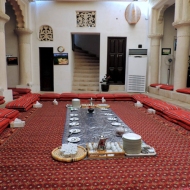DAY 1 DUBAI
Start at the Sheikh Mohammed Center for Cultural Understanding (SMCCU), where you can have a traditional breakfast and learn about the culture of Dubai and the UAE in general. Tradition remains a strong current throughout UAE society, while it adapts to tolerate, if not embrace, some of the modern social mores of the 80-90% ex-pat population.
The SMCCU is located in an old wind-tower house in the Al Fahidi district (also known as Bastakiya) of Bur Dubai on the western side of Khor Dubai (Dubai Creek). The district is named for Al Fahidi Fort, the oldest standing building in Dubai. The residential area that grew up around the fort was planned to make life in the extreme climate as comfortable as possible. Houses were built around narrow, winding lanes to maximize shade and draw cooling breezes through. Towers on the houses drew air down past water, which cooled the rooms as it evaporated on the wind.
Take an abras (water taxi) across the creek to Deira, where you’ll find the souks. If you’ve been to souks in Fez, Istanbul, Jerusalem and Cairo, Dubai’s souks probably won’t blow your socks off, but they do have local charm and are well worth some poking around. The Gold Souk is really something to behold and many visitors to Dubai come just for the gold.
Then travel in a matter of minutes from old Dubai to the number-one icon of new Dubai, Burj Khalifa, the world’s tallest building. I like buildings and have raved about this one more than once in this blog: here and here. Take the At The Top tour for access to the observation deck on the 124th floor. Burj Khalifa is part of the Downtown Dubai development, which includes the Dubai Mall (for a completely different shopping experience from the souks) and the musical Dubai Fountain.
DAY 2 DUBAI
Start the day with breakfast at the Farriers Restaurant with views of horses during morning track work on the Meydan Racecourse. After breakfast, take a tour of the Meydan Stables.
 Drive to the giant Jebel Ali port, about 20 miles south of Dubai city, for a seaplane tour. The aerial perspective really helps to take in the extraordinary evolution of Dubai. You’ll fly over the whole city, but birds-eye views of the man-made Palm Jumeirah and World Islands, the Burj Khalifa and the sail-shaped Burj Al Arab Hotel are especially astonishing.
Drive to the giant Jebel Ali port, about 20 miles south of Dubai city, for a seaplane tour. The aerial perspective really helps to take in the extraordinary evolution of Dubai. You’ll fly over the whole city, but birds-eye views of the man-made Palm Jumeirah and World Islands, the Burj Khalifa and the sail-shaped Burj Al Arab Hotel are especially astonishing.
Come down to earth with a tour through the art spaces on Alserkal Avenue in the industrial Al Quoz district. Since 2007, Alserkal Avenue has developed “organically,” as they like to say, into a hopping arts scene, with the city’s largest concentration of galleries and arts venues. It’s a good place to ground and balance out the hyper-commercialism that built Dubai and keeps it ticking.
Click to see Dubai tours on our website.








































